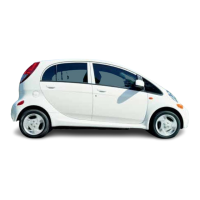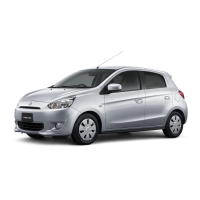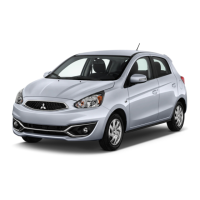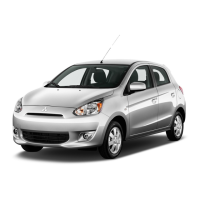Troubleshooting
O-23
IO EGR system not functioning properly (Chapter 6).
11 Use of sub-standard fuel. Fill tank with proper octane fuel.
12 Low or uneven cylinder compression pressures. Check as described
in ,Chapter 2.
13 Air leak at carburetor or intake manifold (check as described in Sec-
tion 8).
14 Dirty or clogged carburetor jets or malfunctioning choke (Chapters 1
and 4).
*
18 Engine backfires
1
EGR system not functioning properly (Chapter 6).
2 Ignition timing incorrect (Chapter 1).
3 Thermostatic air cleaner system not operating properly (Chapter 6).
4 Vacuum leak (refer to Section 8).
5 Valve clearances incorrect - Chapter 1 (four-cylinder engine).
6 Damaged valve springs or sticking valves (Chapter 2).
7 Intake air leak (see Section 8).
8 Carburetor float level out of adjustment (Chapter 4).
19 Engine surges while holding accelerator steady
1 Intake air leak (see Section 8).
2 Fuel pump not working properly (Chapter 4).
20 Pinging or knocking engine sounds when engine
is under load
1 Incorrect grade of fuel. Fill tank with fuel of the proper octane rating.
2 Ignition timing incorrect (Chapter 1).
3 Carbon build-up in combustion chambers. Remove cylinder head(s)
and clean combustion chambers (Chapter 2).
4 Incorrect spark plugs (Chapter 1).
21 Engine diesels (continues to run) after being turned off
1 Idle speed too high (Chapter 1).
2 Ignition timing incorrect (Chapter 1).
3 Incorrect spark plug heat range (Chapter 1).
4 Intake air leak (see Section 8).
5 Carbon build-up in combustion chambers. Remove the cylinder
head(s) and clean the combustion chambers (Chapter 2).
6 Valves sticking (Chapter 2).
7 Valve clearances incorrect - Chapter 1 (four-cylinder engine).
8 EGR system not operating properly (Chapter 6).
9 Fuel shut-off system not operating properly (Chapter 6).
10 Check for causes of overheating (Section 27).
22 Low oil pressure
1
Improper grade of oil.
2 Oil pump worn or damaged (Chapter 2).
3 Engine overheating (refer to Section 27).
4 Clogged oil filter (Chapter 1).
5 Clogged oil strainer (Chapter 2).
6 Oil pressure gauge not working properly (Chapter 2).
23 Excessive oil consumption
1 Loose oil drain plug.
2 Loose bolts or damaged oil pan gasket (Chapter 2).
3 Loose bolts or damaged front cover gasket (Chapter 2).
4 Front or rear crankshaft oil seal leaking (Chapter 2).
5 Loose bolts or damaged rocker arm cover gasket (Chapter 2).
6 Loose oil filter (Chapter 1).
7 Loose or damaged oil pressure switch (Chapter 2).
8 Pistons and cylinders excessively worn (Chapter 2).
9 Piston rings not installed correctly on pistons (Chapter 2).
10 Worn or damaged piston rings (Chapter 2).
11 Intake and/or exhaust valve oil seals worn or damaged (Chapter 2).
12 Worn valve stems.
13 Worn or damaged valves/guides (Chapter 2).
24 Excessive fuel consumption
1 Dirty or clogged air filter e!ement (Chapter 1).
2 Incorrect ignition timing (Chapter 1).
3 Incorrect idle speed (Chapter 1).
4 Low tire pressure or incorrect tire size (Chapter 1;).
5 Fuelleakage.Checkallconnections,linesandcomponentsin thefuel
system (Chapter 4).
6 Choke not operating properly (Chapter 1).
7 Dirty or clogged carburetor jets or fuel injectors (Chapter 4).
25 Fuel odor
1 Fuel leakage. Checkall connections, lines and components in the fuel
system (Chapter 4).
2 Fuel tank overfilled. Fill only to automatic shut-off.
3 Charcoal canister filter in Evaporative Emissions Control system
clogged (Chapter 1).
4 Vapor leaks from Evaporative Emissions Control system lines (Chap-
ter 6).
26 Miscellaneous engine noises
1 A strong dull noise that becomes more rapid as the engine acceler-
ates indicates worn or damaged crankshaft bearings or an unevenly worn
crankshaft. To pinpoint the trouble spot, remove the spark plug wire from
oneplugatatimeandcranktheengineover. Ifthenoisestops, thecylinder
with the removed plug wire indicates the problem area. Replace the bear-
ing and/or service or replace the crankshaft (Chapter 2).
2 A similar (yet slightly higher pitched) noise to the crankshaft knocking
described in the previous paragraph, that becomes more rapid as the en-
gine accelerates, indicates worn or damaged connecting rod bearings
(Chapter 2). The procedure for locating the problem cylinder is the same
as described in Paragraph 1.
3 An overlapping metallic noise that increases in intensity as the engine
speed increases, yet diminishes as the engine warms up indicates abnor-
mal piston and cylinder wear (Chapter 2). To locate the problem cylinder,
use the procedure described in Paragraph 1.
4 A rapid clicking noise that becomes faster as the engine accelerates
indicatesaworn piston pin or piston pin hole. This sound will happen each
time the piston hits the highest and lowest points in the stroke (Chapter2).
The procedure for locating the problem piston is described in Paragraph 1.
5 A metallic clicking noise coming from
the water pump indicates worn
or
damaged water pump bearings or pump. Replace the water pump with
a new one (Chapter 3).

